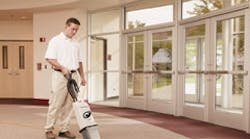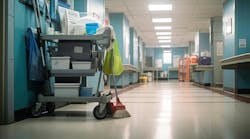Upright vacuums, like cars, vary in quality, features and performance. Like automobiles, some uprights are reliable, others may be problematic, and some become a problem as a result of neglect or improper use.
How do education institutions make an informed choice and, having done so, ensure that an upright vacuum goes the distance?
Thinking ahead
A “road test” with a loaner unit makes sense, but schools also should consider “under-the-hood” facts and long-term issues:
- Soil-removal testing
How well does it clean? Because soil removal directly affects a carpet's longevity, appearance and related long-term expenses — and indirectly affects the health of building occupants — it is a vital part of overall “cost.”
The Carpet and Rug Institute (CRI) tests vacuums for soil removal as part of its voluntary Green Label Vacuum (GLV) Program, and soon will apply NASA Space Shuttle technology called XRF (X-Ray Fluorescence) to determine even more precisely how much soil (and what type) remains in cleaned carpet, and thus how well a vacuum performs under various conditions. For a list of Green Label vacuums, visit www.carpet-rug.org.
- Filtration testing
How well does the vacuum filter? Again CRI's GLV standard is a helpful benchmark. CRI states: “The vacuum must not release more than 100 micrograms of dust particles per cubic meter of air. This protocol evaluates the total amount of dust particles released by the brush rolls, through the filtration bag and via any air leaks from the system.”
Has the vacuum been tested in a chamber to determine overall emissions from the entire machine? As CRI indicates, regardless of whether the vacuum has HEPA, micro filter or other media, filtration should be measured by overall dust capture from all possible escape points (filters, body seams, vacuum tools, point of contact with cleanable surfaces) rather than just at the filter.
Is more than one type of filter bag available? Micro filter bags greatly surpass dust capture vs. single-ply generic filter bags. One study by the Journal of Allergy and Clinical Immunology showed that quality micro filters can remove nearly 2,400 percent more dust than generic single-ply bags.
Of course, in addition to providing health protections, better filtration reduces residual dust accumulation and the time it takes to dust — a powerful benefit in an industry whose primary investment (and expense) is labor.
- One motor or two?
Two-motor uprights generally clean better than single-motor uprights. One dedicated motor creates suction, while the other drives the rotating brush, increasing productivity and decreasing labor costs.
According to the ISSA's “447 Cleaning Times” booklet, a dual-motor 14-inch upright can clean 1,000 square feet in 18.50 minutes compared with 21 minutes for a 14-inch single-motor upright; that's 3,243 vs. 2,857 square feet per hour, or a productivity difference of 386 square feet per hour. Likewise, a 14-inch dual-motor upright cleans 1,004 more square feet per hour than a 12-inch single-motor upright.
- Construction and design factors
Examine the base plate that frames the beater brush. Is it little more than a flat metal or plastic panel, or is it engineered to enhance airflow? Some models have a base plate with integrated conduits to accelerate airflow for more effective cleaning.
What are the options in beater brushes? Finished hardwood beater brush dowels can reduce the buildup of static electricity vs. plastic rollers and are less likely to damage carpet than rigid steel dowels.
Have the body integrity and seals been checked? Is the vacuum engineered using close tolerances and good seals to prevent dust from escaping where it shouldn't? Also, for getting under furniture and around carpet edges, the vacuum's footprint, edge and airflow design should enable it to get deep under furniture, and close to walls and corners.
Does the vacuum's power-head feature automatic adjustment for various types of surfaces and carpet heights? This feature saves time, optimizes cleaning and prevents damage to varying surfaces, while reducing strain on drive belts.
- Durability
Are body materials reinforced? High-quality vacuum cleaner bodies often are reinforced with “ribs” or struts similar to the way car doors are reinforced to make them strong and lightweight. One way to check: open the filter bag housing and look for reinforcing ribbing.
Handle design and construction are crucial to durability and ergonomics. Newer, high-strength synthetic materials enable molded, one-piece vacuum handles that are strong, flexible and lightweight.
How about belts? Are they the “rubber-band” type that stretch over time, lowering brush performance, and need frequent replacement? Or are the belts designed like automotive timing belts — geared with woven fibers running their length to ensure durability in the same way steel belts strengthen radial tires? Also, and perhaps most important, a sprocketed belt does not slip, ensuring consistent brush RPM — and cleaning.
- Upkeep
As with an automobile, commitment to upkeep (e.g., filter changing, motor maintenance) is critical for an upright vacuum.
Change vacuum filters regularly (when bags are half full or before). Fresh bags clean better and optimize labor, keep air moving freely to prevent motors from overheating, and lighten/reduce the push-pull effort required by the operator.
Check beater brushes and replace bristles periodically to ensure maximum sweeping and cleaning effectiveness.
Other brushes need regular attention too, especially motor brushes. Not “brushes” in the usual sense, these small blocks of carbon lightly press or brush against the rotating part of the vacuum's electric motor, transferring electricity. They wear out eventually.
Why bother to replace these? It can make the difference between 1,400 or more hours of motor life and 900 hours or less — extending the operating cycle of the vacuum motor by 50 percent or more.
One manufacturer suggests motor-brush changing after the first 800 hours, then again after an additional 400 hours, and again after the next 200 hours.
How to keep up? Determine how many hours the vacuum is used daily, then create a schedule for motor brush replacement — a task best handled by a qualified service department, a local distributor or mechanically inclined user.
- Service and support
Questions to ask: How easy is the vacuum to repair? How accessible are the parts that wear out? What type of warranty does the manufacturer provide: six months? three years? Parts and labor? Lifetime warranty on what? What does the fine print say?
Call the manufacturer's customer service department to “test drive” the support provided. Ask about turnaround time and cost for repairs or part replacements, availability of high-wear parts and other service points.
- Cost of ownership
Cost of ownership involves more than a vacuum's sticker price. Consider performance, durability, downtime and other issues.
Keeping costs in line also involves properly scheduling and work loading the cleaning. Plan the route through the building to minimize the need to plug/unplug and backtrack. Perform the cleaning when areas are least used and most accessible.
Rathey is president of InstructionLink/JanTrain, Inc., Boise, Idaho.
Cleaning study documents disinfection
A pilot study at the University of North Carolina at Chapel Hill (UNC) examined comparative cleaning and health-related outcomes, including aerobic bacteria counts before and after restroom cleaning using the (OS1) system vs. a traditional zone cleaning system. The 90-day pilot study, conducted in 2006, compared the effectiveness of zone cleaning methods used at Dey Hall with the (OS1) cleaning methods tested at Carroll Hall. The (OS1) system approaches cleaning in a systematic manner and incorporates continuous improvement to management processes.
Dr. Michael Berry, a retired UNC professor, former head of the U.S. EPA's Indoor Air Quality Research Program and a pioneer of research on cleaning effectiveness, served as technical adviser to the pilot program.
Berry, along with the UNC environmental health department staff, took bacterial swab samples at the beginning for a baseline, at the midpoint and at the end of the pilot to compare the (OS1) cleaned building with the adjacent zone-cleaned building. Forty swabs of bacteria were taken from five surfaces in two restrooms on each floor.
According to Jim Alty, facilities director, the cleaning staff had been doing a good job cleaning restrooms prior to the pilot program, so the swab test results did not surprise him. Total colony forming units (CFUs) — a measure of bacterial concentration for a given sample — actually were similar after (OS1) cleaning vs. after zone cleaning; this contrasted with Dr. Berry's sampling of mold spores in the same two buildings that showed major reductions in residual dust particulate using (OS1).
The surprise was in the total reduction of chemicals — and related chemical exposures — necessary to achieve desired results.
“(OS1) and zone cleaning both reduced bacteria counts to about the same end state, but (OS1) was able to do it with fewer chemicals,” says Alty. “Dr. Berry showed we were getting cleaner results or the same level with less chemical or supply use.”
In addition, under (OS1), janitors used not only fewer, but also safer chemicals, reducing the potential for exposure-related health problems, noted Alty. High-quality results were produced without an increase in the cost of cleaning.
Moreover, the study determined that (OS1) produced a consistent sanitary condition in restrooms using a single-portioned disinfectant. In contrast, zone programs at UNC typically used five to eight different cleaning chemicals. During the study, housekeeping closets in the zone area were found to be potentially unsafe with unlabeled or empty chemical containers present, residue from chemicals compromising surfaces, and drink bottles placed next to cleaning containers. In addition, zone cleaning experienced significant waste, as many of the chemicals used or in inventory were ineffective or unnecessary.
The study found that under the (OS1) program, cleaning workers and building occupants have less chemical exposure — and less environmental compromise — for several reasons. The chemicals are supplied in preportioned plastic packs. Cleaners use only what they need, and empty packages are accounted for and recycled, thereby reducing waste and environmental impact, while increasing safety and effectiveness.
18.5
Number of minutes it takes a dual-motor, 14-inch upright to clean 1,000 square feet.
21
Number of minutes it takes a single-motor, 14-inch upright to clean 1,000 square feet.
Source: ISSA's “447 Cleaning Times” booklet.
The basics of airflow, lift and filtration
Airflow is the amount or volume of air moving through the vacuum, usually measured in cubic feet per minute (CFM). The amount of air moving through a vacuum affects the amount of soil that can be carried along by the airflow and contained in the vacuum's filtration.
Lift, also known as static lift or water lift, is the ability of the vacuum's airflow to lift dirt. It typically is measured in “inches of lift,” determined by how many inches the vacuum cleaner's airflow can pull water up a tube in a lab test. The higher the two numbers — airflow and lift — are, the better, since this combination largely determines the vacuum's ability to pull “particles in.”
Filtration captures the soils and is mainly responsible for reducing “particles out.” Filtration must be designed and proportioned to work with the vacuum's airflow and lift so that the particles are stopped, but not the airflow.


